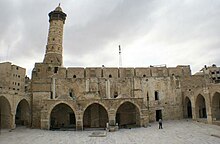Daraj Quarter

Al-Daraj or Haraat al-Daraj (Arabic: حارة الدرج) is the densely populated northwestern quarter of the Old City of Gaza. [1][2] Its name translates as "Quarter of the Steps."[3] Situated on an oblong hill about 20 meters (66 ft) above sea level and higher than any other area in the city, al-Daraj likely received its name either from stairs that once led to it or from the feeling of climbing steps when attempting to reach the neighborhood. It is also referred to as the "Muslim Quarter" and contains several mosques and other Muslim edifices. Among them are the city's largest mosque, the Great Omari Mosque, as well as the al-Sayed Hashem Mosque, the Sheikh Zakariya Mosque, the Sheikh Faraj Mosque and Madrasa al-Zahrah.[4] Al-Daraj is separated from the southern Zaytun Quarter by Omar Mukhtar Street.[5]
It is the oldest populated area of the city, being built over the site of ancient Gaza.[6] The remnants of the city's ancient past are visible in many of the neighborhood's stone houses where marble columns and slabs have been reused as building materials. According to Ottoman tax records, al-Daraj was a relatively large neighborhood in 1525, with 141 households. Containing Qasr al-Basha, it was the seat of power for the provincial governors of Gaza and much of Palestine during Mamluk and Ottoman rule over the city by at least the 17th century.[4] At the end of the 19th century, it was called Haret ed-Deredj.[7]
Historical Significance of Al-Daraj within Islamic History
[edit]Hashim ibn Abd Manaf and the Sayed al-Hashim Mosque
[edit]Al-Daraj is the burial place of Hashim ibn Abd Manaf, the great-grandfather of Muhammad. Hashim, the third Major Chief Leader of the Quraysh tribe of Mecca,[8] died in Gaza in 497 CE while traveling on a trade journey. The Sayed al-Hashim Mosque, built around the 12th century, marks his gravesite.[9] It is named in honor of Hashim and his descendant, Muhammad.
The burial site in Al-Daraj is the source of one of Gaza's names, "غزة هاشم" (Ghazzat Hashim), literally translating to "Hashim's Gaza.".[10]
See also
[edit]- Palestine
- Gaza
- Islam
- Al-Daraji
- Israeli–Palestinian conflict
- Great Mosque of Gaza
- Daraj Tuffah
- Daraj Media
References
[edit]- ^ Sharon, Moshe (2009). "Gaza". Corpus Inscriptionum Arabicarum Palaestinae. Vol. 4. BRILL. pp. 28–30. ISBN 90-04-17085-5.
The old city of Gaza, where all the remnants of the ancient, medieval and early Ottoman city are found, is divided into four quarters, a few of which are subdivided. Three of these quarters (at-Tuffäh, ad-Daraj, and az-Zaytun) were within the walls of the ancient city. The southeastern quarter, as-Saja'iyyah, developed later than the others, mainly outside these walls… The four quarters of the city are as follows… In the northwest (generally, west): Hãrat (or Hayy) ad-Daraj ("the Stairs Quarter"). This is the oldest part of the city, or the city of Gaza proper, situated on an oblong hill, some 20m. higher than the surrounding plain and the other parts of the city. It probably received its name from stairs that led to it, or from the feeling of whoever went up to it that he was climbing stairs…
- ^ Roy, 2011, p. 40
- ^ Meyer, 1907, p. 108
- ^ a b Sharon, 2009, p. 29
- ^ Sharon, 2009, p. 30
- ^ Cohen and Lewis, 1978, pp. 117-119; cited in Sharon, 2009, p. 62
- ^ Guérin, 1884, p. 251; cited in Cohen and Lewis, 1978, pp. 119
- ^ "Family Tree of the Early Muslim Leaders from the tribe of Quraysh".
- ^ Hooda, Samreen (September 2006). "Mosque of Sayyed Hashim - Gaza". This Week In Palestine. Palestine. Retrieved 17 January 2012.
- ^ https://www.alghad.tv/%D9%85%D8%A7%D8%B0%D8%A7-%D8%AA%D8%B9%D8%B1%D9%81-%D8%B9%D9%86-%D8%BA%D8%B2%D8%A9-%D9%87%D8%A7%D8%B4%D9%85%D8%9F/ [bare URL]
Bibliography
[edit]- Cohen, Amnon; Lewis, Bernard (1978). Population and Revenue in the Towns of Palestine in the Sixteenth Century. Princeton University Press. ISBN 0-691-09375-X.
- Guérin, Victor (1884). La Terre sainte (in French). Vol. 2. Paris.
{{cite book}}: CS1 maint: location missing publisher (link) - Meyer, Martin Abraham (1907). History of the city of Gaza: from the earliest times to the present day. Columbia University Press.
- Sharon, Moshe (2009). Corpus Inscriptionum Arabicarum Palaestinae, G. Vol. 4. BRILL. ISBN 978-90-04-17085-8.
- Roy, Sara (2011). Between Extremism & Civism: Political Islam In Palestine. Princeton University Press. ISBN 978-0-691-12448-3.
